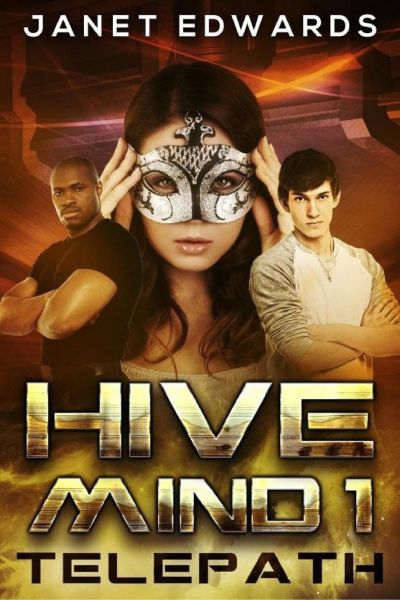Every Smile You Fake
Telepath (Hive Mind, volume 1)
By Janet Edwards

23 Oct, 2019
2016’s Telepath is the first volume of Janet Edwards’ Hive Mind series.
In the Hive cities of the future, everyone is tested at eighteen, then assigned a niche, some useful role for which they are well suited and in which they will be content. An unlucky few are assigned a role with which they may not be content. But it’s a necessary role, so must be filled.
Amber is unlucky. Amber is a telepath. She has a job to do, whether she likes it or not.
Telepaths are necessary if the Hive is to be kept in order. Partial telepaths are assigned to do counselling and treatment — roles perhaps a bit taxing, but tolerable. Amber is a full telepath, assigned to detect malcontents, wild bees, before they act out. Amber tips off the police, who will track and detain the wild bees before they can do much damage.
There are too few full telepaths to properly surveil the Hive. Five telepaths for a hundred million people. The government doesn’t want Hive members to know this; the fact might encourage the wild bees. The official position is that there are MANY telepaths. The unofficial practice is to push the telepaths to their limits, in an attempt to keep order in the Hive. Amber may crack under the strain, suicide, or just lose her abilities through overwork. Too bad for Amber.
The Hive does do its best to keep its team of telepaths as happy as they can be under the circumstances. Amber may have to spend her life poking into the minds of seriously unhappy people; she may be forbidden from discussing her true role with her family, but in return she is given status and wealth. The Hive is, after all, not malicious, merely determined to survive.
Amber’s first few cases go well enough. But soon she and her team find themselves drawn into what they belatedly realize are traps. Someone out there is determined to hurt Amber and her team. That someone knows enough about telepath operations to target them quite effectively.
What Amber does not know is that the player on the other side isn’t targeting Amber and her team. He’s targeting Amber. And he’s had years to plan his endgame.
~oOo~
This book is aimed at younger readers. The worldbuilding is thin and the prose isn’t challenging. The characters are straightforward. But the novel isn’t a predictable rehash of outworn tropes.
People didn’t move to the Hives because some vast calamity drove them underground or into floating cities or into fortified domes. They weren’t pushed by population pressure. (World populations are much lower in Amber’s time than in ours.) People moved to cities because cities were attractive places to live; cities evolved into Hives.
The Hives aren’t grimdark dystopias (which one might expect from the synopsis above). This is less because the people in charge1 are nice people, but because they are realists. Previous regimes tried various dystopian solutions and they didn’t work. Keeping Hive members happy works.
(My eyebrows are raised so high they have crawled over the top of my head and down my back. What sort of futuristic world is this? Not the ones I know.)
It’s true that there are some obvious drawbacks to the Hive solution, but they aren’t deal-breakers. The system is so stable it’s stagnant: skills can be decanted directly into brains so most people never learn how to learn. The powers that be resort to some fairly Orwellian methods to keep people content; traumas are erased from memory and people reassigned to avoid triggers. People are discouraged from thinking about the outside world, or even other Hives (leading to a Caves-of-Steel-style aversion to the countryside). Finally, while the government mostly lives by “first, do no harm,” there’s a threshold beyond which the characters, including Amber herself, are willing to resort to brutal methods for the greater good.
Well, who is gunning for Amber? I didn’t suss that out in the first few chapters, so this book passes one test for a readable mystery. When we do learn whodunnit, the answer makes sense in the context of the world the author has built. The book also passes the Manila Envelope Test. You can’t swap out the central MacGuffin for a manila envelope without breaking the plot. This shouldn’t be rare in SF mysteries — but it is. It’s enough to convince me to seek out more books by this author.
Telepath is available here (Amazon), here (Amazon.ca), here (Amazon.co.uk). If it is available from Chapters-Indigo, that fact is effectively hidden.
1: Whoever the powers that be might be. At this point, it might not matter since everyone is programmed to fill their role, telepaths excepted.
